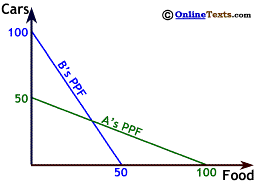

Copyright © 1995-2004 OnLineTexts.com, Inc. - All Rights Reserved
 Utilizing its comparative advantage, Country A realizes gains from trade by specializing in Food production. If instead, County A's government subsidizes Car production and then exports Cars, it discourages the benefits from specialization and trade. Worse still, by encouraging export of a product at a price below cost, the government forces the country onto a PPF below its own no-trade PPF.
Utilizing its comparative advantage, Country A realizes gains from trade by specializing in Food production. If instead, County A's government subsidizes Car production and then exports Cars, it discourages the benefits from specialization and trade. Worse still, by encouraging export of a product at a price below cost, the government forces the country onto a PPF below its own no-trade PPF.
Each Car produced in Country A costs (or uses up) 2 Food units, even if subsidies are given to car makers. If the subsidized Cars are then sold to Country B for 1/2 a unit of Food, the country loses 1.5 units of Food for each exported Car. Even though auto makers may be compensated the missing 1.5 units, it doesn't change the fact that Country A used up 2 units of Food in the production of each Car.
On the graph to the right, we show various PPFs faced by Country A depending on the number of Cars it exports. On the PPF labeled EX-10, Country A exports 10 Cars. Country A uses up 20 units of Food in their production of the Cars and only gets back 5 units of Food from buyers in Country B, leaving Country A capable of producing only 85 units of Food for domestic consumption (or Car-Food combinations, shown along the PPF labeled EX-10).


Copyright © 1995-2004 OnLineTexts.com, Inc. - All Rights Reserved